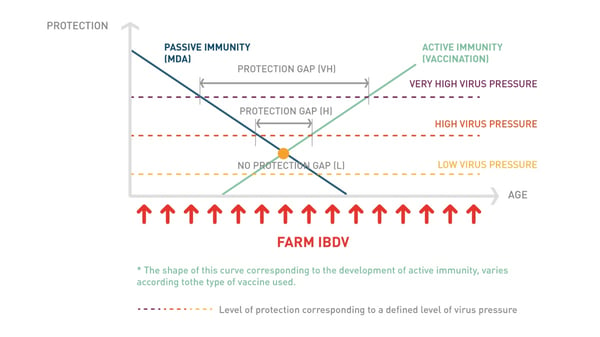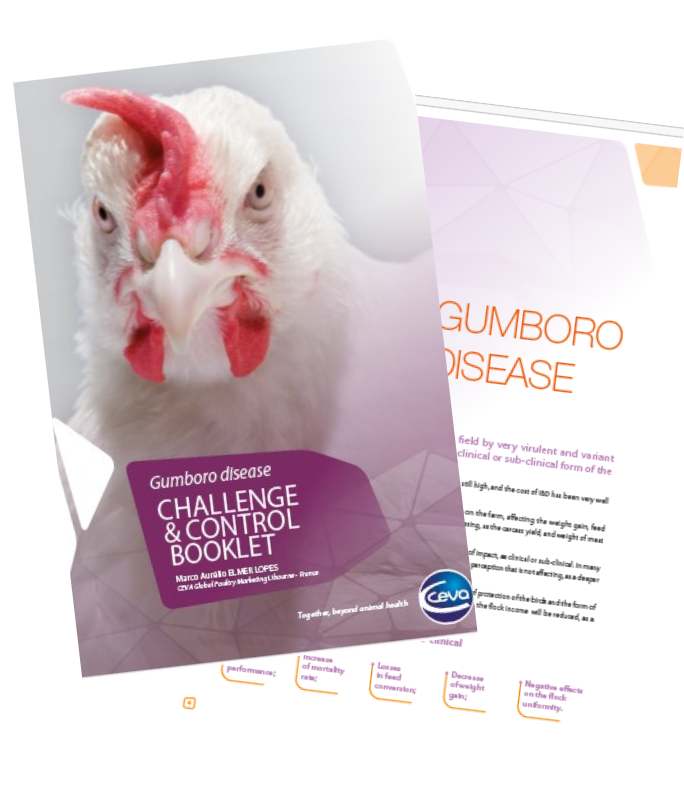After the initial outbreak in the USA (Town of Gumboro, Delaware), the Infectious Bursal Disease (IBD) in the clinical form was reported in many other countries in the 1960s and 1970s.
Around 1985, more virulent forms were reported with a very immunosuppressive form of IBD in the USA, which then later spread to Central and South America. Around the same time, the very virulent (vvIBDV) form of IBD spread to Western Europe, Northern Africa, the Middle East and Asia. Then, in the late 1990’s and early 2000’s, the very virulent form spread to Central, South America and California.
This is probably the most critical time to select and implement an effective control program
Today, sub-clinical Gumboro Disease is the most frequent form, despite the fact that the very virulent form is still predominant in some countries; however, this does not mean that the virus has gone or has lost its pathogenicity. On the contrary, past experience is telling us that this is probably the most critical time to select and implement an effective control program. The heart of the problem is the Gumboro virus, not necessarily Infectious Bursal Disease.
So, to control the Gumboro virus (IBDV) is important to know how it is transmitted.
Transmission In The Poultry House
 The first important point to understand is that the Gumboro virus is a Resident virus in the poultry house. This means that the Bursa de Fabricius of the chickens will be infected after the decrease of the Maternal Delivered Antibodies (MDA) levels, and the transmission can occur from one bird to another, or from one flock to another. This way, a virus that is present in the poultry house, or shed by another chicken, will be transmitted to the co-housed chickens.
The first important point to understand is that the Gumboro virus is a Resident virus in the poultry house. This means that the Bursa de Fabricius of the chickens will be infected after the decrease of the Maternal Delivered Antibodies (MDA) levels, and the transmission can occur from one bird to another, or from one flock to another. This way, a virus that is present in the poultry house, or shed by another chicken, will be transmitted to the co-housed chickens.
Many factors explain the nature of an IBD transmission, but when it comes to the farm situation four of them are the most critical:
- Farm IBDV
- Virus pressure
- Passive immunity (MDA)
- Active immunity
Farm IBDV
The Farm IBDV is the Gumboro virus that is already present when the day-old chicks are delivered, and which is very likely to infect them once they become susceptible.
The Gumboro Disease virus is extremely resistant and, even after strict cleaning and disinfecting procedures, it is very likely to persist in the environment and therefore already be present inside the house even before the day-old chicks are released onto the floor.
The IBDV “population” will build up according to many factors, especially considering the previous flocks based in that house. This means that if the previous flocks were not well protected, or faced an outbreak, the field virus will remain for the next flock.
This way, the control of farm IBDV will drive the virus pressure.

Virus Pressure
The virus pressure (also called challenge pressure) indicates the amount of virus that is challenging the chickens. It is related to the management system applied at the farm (‘all-in, all-out’, accumulated litter, multiage, cages, etc.) as well as to the quality of cleaning and disinfection and the situation of the farm relative to other neighboring farms.
Virus pressure also varies in the course of the growing period. If IBDV is successful in infecting some chickens, then these chickens will multiply the virus, shed it, and in doing so, contribute to an increase in the virus pressure. The higher the virus pressure, the higher the risk of infection, and the stronger the clinical consequences - and economic impact.
Passive Immunity
Passive immunity provided by Maternally Derived Antibodies (or MDA) plays a critical role in containing virus pressure and preventing infection as long as it is present in the chicken in a sufficient concentration (= at a sufficient level). After an increase observed during the first days after hatching, and due to the release of immunoglobulins still present in the yolk sac into the bloodstream, the MDA level declines according to the time and the growth rate of the chickens, until it reaches a non-protective level corresponding to age and increasing the susceptibility of the chickens.

Active Immunity
Active immunity (or vaccine immunity) induced by administration of a vaccine will develop according to the vaccine(s) employed, the quality of application and immune status of the chickens at the time the vaccine(s) is (are) given.
All Gumboro vaccines employed to induce immunity against Gumboro Disease are live vaccines, either of the attenuated type, the immune complex type, or of the recombinant vector type.
Consequently, they all need to replicate (i.e. to ‘take’) to ‘work’. The ‘take’ of a live Gumboro vaccine depends on the right timing of application because of interference with MDA. Administering too early when the level of MDA is high will mean that the vaccine virus is neutralised; however, if it is administered too late then there’s too large a window of opportunity for the farm virus to infect the flock. This problem of timing has been solved by the development of Gumboro hatchery vaccines (Immune Complex) that have the capacity to overcome interference from passive immunity whatever the level.
The ‘take’ also depends on the quality of application, which is extremely critical, and can be unreliable in cases of farm application. Proper administration of the vaccine must ensure the full dose is received by every bird. The capacity of a vaccine strain to overcome MDA is also linked to the dose of vaccine administered.
Managing the Challenge
In summary, the challenge is expected to be earlier if the MDA level is low, if virus pressure is high, if the challenging virus is more virulent or is antigenically different from the the ones that have been used to vaccinate or challenge the breeders.



